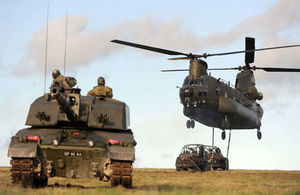Niteworks 3: Improving Army capability delivery through industry best practice
To bring Industry best practice of Project, Programme and Portfolio Management (P3M) and to tailor this to the British Army’s needs.

MOD Crown Copyright
Background
Following MOD Defence Reform, Army HQ needed to assure that the £1.6bn annual capability change budget was spent efficiently and in accordance with best commercial and management practice. The adoption of Portfolio, Programme and Project Management (P3M) was necessary to ensure that Army HQ had the right governance, processes and people to deliver programmes and projects to time, on budget and with the right performance.
Niteworks Task
Niteworks was tasked to bring industry best practice, skills and experience to the project’s three principle aims:
- To pilot and de-risk P3M processes within the four programmes of Watchkeeper, Chinook, Armoured Cavalry and Land Environment Tactical Communications and Information Systems (LE TacCIS)
- To develop P3M process requirements tailored to meet the Army’s needs
- To increase awareness and proficiency to enable the transition to best practice P3M
How did Niteworks approach the task?
The project team brought in subject matter experts from across industry via the Niteworks partnership to work jointly with Army HQ stakeholders. The team undertook one-to-one engagements, and used a series of pan-industry workshops to refine and validate the tools and processes that were to be piloted. Rehearsal forums were used to test how the processes would work and ensure consensus, buy-in and wider knowledge dissemination.
Building on earlier work, four Programme Proof of Concept (POC) engagements were undertaken to develop P3M competencies focussing on risks, benefits and dependencies. The team spent eight weeks with each programme team to review the programme, identify areas for improvement (which varied with each programme) and bring non-proprietary best practice to bear, tailored to meet Army needs.
The team designed, produced and embedded industry informed and tailored P3M processes and artefacts at the portfolio and programme level through coaching and knowledge transfer.
What was the outcome?
The Niteworks team enabled the Army to understand P3M support requirements and how it may be resourced going forward. The team identified the specialist skills needed for the Army Portfolio Office, defined the functions and proposed an approach to implement these functions, along with portfolio governance and management structures.
At the programme level, this enabled the identification of dependencies and projected programme outcomes, and at the portfolio level they developed a P3M data schema to enable the Army to drive for a consistent and coherent approach to P3M data management.
An Outcome Relationship Model was recommended in order to develop a high level programme schedule and manage the programme effectively and efficiently. Risk management was improved by simplifying the risk data schema, clarifying the programme risk management processes with a new policy document and transferring skills.
Awareness was raised at 1* level and above of the need for senior P3M leadership through a Knowledge, Skills and Experience paper. The paper highlighted the organisational advantage the P3M provides and the need for an improved career structure and P3M career paths to be identified.
What were the benefits of the programme?
Army HQ accepted the recommendations and new ways of working, which have been implemented. By embedding industry informed and tailored P3M processes and artefacts,
Army HQ is now able to ensure:
- delivery assurance of Programmes across performance, cost and time
- more effective Programme resource management
- proactive and effective risk management at Programme and Portfolio level
- more efficient and timely decision making at Programme level focused on the delivery of the intended benefits of the Programme
- greater coherence between projects
- greater capability integration